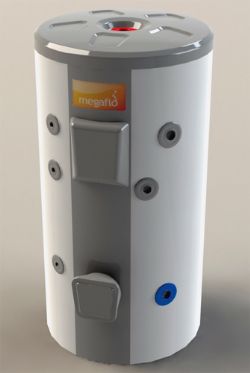It pays to research and assess the material an unvented water heating cylinder is manufactured from, as well as its operating pressure, flow rates and recovery times, says John Forster
Unvented cylinders are fed directly from the cold water mains, providing a powerful and consistent flow of hot water at high pressure to all taps and showers, without any significant loss of performance if they are used simultaneously.
Though primarily used in the domestic sector to provide mains pressure hot water for powerful showers and fast filling baths, unvented cylinders are found in commercial applications too. And there are many commercial and public sector buildings with a large demand for hot water, where a number of sinks, showers and baths are in simultaneous, sometimes constant, use. Examples include hotels, guest houses, hospitals, care homes, schools and universities, leisure centres, sports clubs, holiday parks, swimming pools and office blocks.
While there are many commercial unvented cylinders on the market suitable for these applications, historically it's been difficult to compare products and find something that's 100 per cent right. Decisions can therefore come down to availability and cost and this can often prove a false economy.
So, what are the key things to look out for when selecting a commercial unvented cylinder?
Since unvented cylinders store water under pressure, they must be strong, durable and corrosion resistant. In the UK, cylinders are generally made from stainless steel, copper or glass-lined mild steel, but high-grade Duplex stainless steel is the preferred material.
Duplex stainless steel has outstanding and unique corrosion-resistant properties, and, being lightweight yet very strong, has a strength-to-weight ratio advantage. Importantly, it also significantly reduces maintenance requirements and costs, and eliminates the need for a protective coating and sacrificial anode. Cylinders manufactured from mild steel require a coating or glass lining to make them corrosion-resistant. They also require an anode, as do some cylinders made from lower-grade stainless steel. Anodes need to be inspected for signs of erosion each year and replaced if deemed necessary.
Mild steel or low-grade stainless steel cylinders cost less than those manufactured from high-grade stainless steel. However, specifiers should be wary - these less expensive products will require ongoing service, regular maintenance and possible replacement after a relatively short life.
While we appreciate that cost will always play an important part in the specification process, choosing high quality, 'fit and forget' unvented product makes sound economic sense.
Mild steel glass-lined cylinders are also around 50 per cent heavier than an equivalent stainless steel unit, and are therefore more difficult to manoeuvre and install.
It's also well worth analysing a cylinder's operating pressure. This is particularly important if it's going to be installed in a tall building with a ground-floor central plant room - even more so if it has a residential element or if it's a hotel or leisure centre with lots of showers in use at the same time.
Buildings with over 25 floors are springing up in both in the residential and commercial sector - especially in London. A cylinder with a high operating pressure will ensure a good hot water supply goes round the whole building. Six or seven bar pressure has typically been the norm.
Even if it's not needed on paper, having additional pressure provides a degree of leeway in case unforeseen circumstances arise in future. For example, additional showers might be added, or the calculated pressure could change during the installation if pipework has to be routed differently.
Choosing a cylinder with a high flow rate is also important. Not only will this give better performance, but it also allows more taps and showers to be served.
Another key factor is hot water recovery, especially if there's going to be a constant demand for hot water, as would be the case in, say, a swimming pool, hotel or hospital. Sometimes it's difficult to estimate how much hot water will actually be used in real life, especially on a new project, so fitting a fast-recovery cylinder can ensure the customer's requirements are met.

Fast-recovery cylinders can also save space as less water actually needs to be stored. This can be a real benefit if space is at a premium, which is often a key consideration on new build projects.
Instead of installing one large cylinder, several smaller fast-recovery units could be installed in parallel. This can be a useful approach where maintenance is concerned, as when individual units need to be shut down for routine servicing or repair the hot water supply won't be disrupted.
As a guide on flow rates and fast recovery, our own Megaflo Commercial delivers hot water at up to 90 litres per minute and can heat up to 2,500 litres in less than 60 minutes.
Specifiers should be able to find exactly the right unvented cylinder for a commercial application without having to make any compromises.
In the past this hasn't always been easy, but, nowadays, appropriate solutions can be found by researching and assessing materials, operating pressures, flow rates and recovery times.
// The author is product manager at Heatrae Sadia //